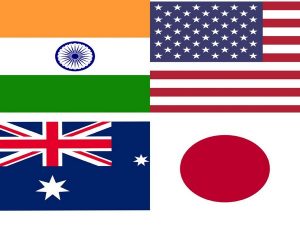First in-Person Meeting Of Quad Countries:

The first in-person meeting of Quad leaders was hosted by the US. Issues like climate change, Covid-19 pandemic and challenges in the Indo Pacific, amidst China’s growing military presence in the strategic region, were discussed in the meeting.
- In November 2017, India, Japan, the US and Australia gave shape to the long-pending proposal of setting up the Quad to develop a new strategy to keep the critical sea routes in the Indo-Pacific free of any influence.
- China claims nearly all of the disputed South China Sea, though Taiwan, the Philippines, Brunei, Malaysia and Vietnam all claim parts of it.
- The South China Sea is an arm of the Western Pacific Ocean.
- In 2020, the trilateral India-US-Japan Malabar naval exercises expanded to include Australia, marking the first official grouping of the Quad since its resurgence in 2017.
- Further, it is the first joint military exercises among the four countries in over a decade.
- In March 2021, the Quad leaders met virtually and later released a joint statement titled ‘The Spirit of the Quad,’ which outlined the group’s approach and objectives.
- Further, just before this meeting, the US has announced a new trilateral security partnership for the Indo-Pacific, between Australia, the UK and the US (AUKUS).
Major Highlights of the Quad Summit:
- Discussed Afghanistan and agreed to deepen their cooperation in South Asia.
- Quad Vaccine Initiative: Under this, the Quad countries have pledged to donate more than 1.2 billion Coid-19 vaccine doses globally, in addition to the doses financed through Covax.
- Building Back Better Health Security: Supported the call for a “global pandemic radar” to improve viral genomic surveillance and expand the WHO Global Influenza Surveillance and Response System (GISRS).
- Quad Infrastructure Coordination Group: The G7 grouping has recently announced the Build Back Better World (B3W) initiative.
- Based on similar lines, the Quad will establish high-quality infrastructure and will share expertise, capacity, and influence in the region and identify new opportunities to meet the needs there.
- Tackling Climate Change: In this context, Quad countries has envisaged to establish:
- Green-Shipping Network for deployment of green-port infrastructure.
- Clean-Hydrogen Partnership to strengthen and reduce costs across all elements of the clean-hydrogen technology, leveraging existing bilateral and multilateral hydrogen initiatives in other fora.
- Climate Adaptation, Resilience, and Preparedness for increasing the Indo-Pacific region’s resilience to climate change by improving critical climate information-sharing and disaster-resilient infrastructure.
- Apart from this, Quad countries intend to update or communicate ambitious NDCs (Nationally Determined Contributions) by COP26.
- The Quad Fellowship: The Fellowship will sponsor 100 students per year – 25 from each Quad country – to pursue masters and doctoral degrees at leading STEM (Science, Technology Engineering, and Mathematics (STEM) programmes) graduate universities in the United States.
- Semiconductor Supply Chain Initiative: It will be a joint initiative to map capacity, identify vulnerabilities, and bolster supply-chain security for semiconductors and their vital components.
- This initiative will help ensure Quad partners support a diverse and competitive market that produces the secure critical technologies essential for digital economies globally.
- Critical and Emerging Technologies: The announcement of launch of a 5G deployment and calls for monitoring trends in advanced biotechnologies, including synthetic biology, genome sequencing, and biomanufacturing.
- Quad Senior Cyber Group: This group will make shared cyber standards; development of secure software; building workforce and talent; and promoting the scalability and cybersecurity of secure and trustworthy digital infrastructure.
- Satellite Data Sharing: The Quad will begin space cooperation for the first time with a new working group.
- In pursuance of this, Quad countries will start discussions to exchange Earth observation satellite data and analysis on climate-change risks and the sustainable use of oceans and marine resources.




